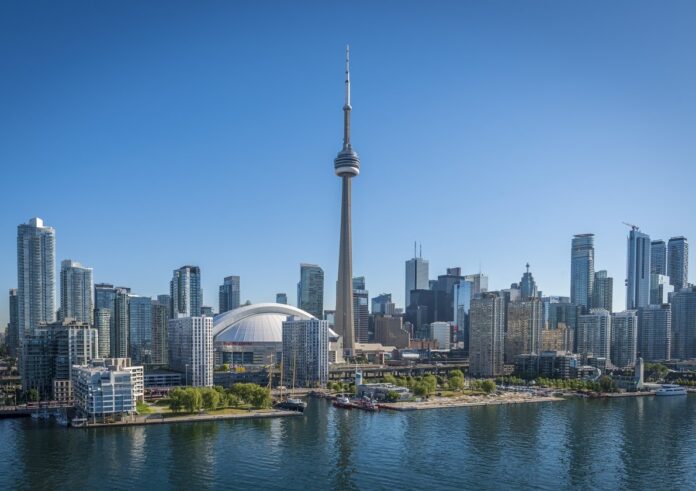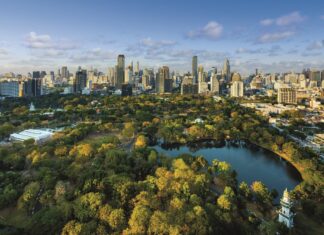Toronto Water has transformed the city’s water management. Ahead of IWA’s World Water Congress & Exhibition in the capital of the Canadian province of Ontario, and with registration now open, the utility highlights the work that has benefitted households and businesses across the city.
With the 2024 IWA World Water Congress & Exhibition arriving in Toronto, Canada, on the shores of Lake Ontario this coming August, the work of city utility Toronto Water will be very much on show to the global water community. Headed by Lou Di Gironimo, general manager of Toronto Water since 2005, it is one of the largest public utilities in North America. The utility is a division within the City of Toronto, and it ensures almost 4 million residents and businesses in the city and surrounding areas have access to safe drinking water, safely treated wastewater, and stormwater management.
Toronto Water’s assets represent a value of CAD$87.3 billion. Its 10-year (2023-2032) capital plan represents an investment of CAD$15.5 billion, and operating and capital budgets are currently fully funded on a ‘pay-as-you-go’ basis through a combined water and wastewater rate with no reliance on property taxes or borrowing/debenture financing. Today, Toronto Water has no debt, as a result of a transformation of the utility’s financial model.
In the early 2000s, after the city underwent a significant amalgamation, it was clear operating costs were exceeding levels of capital investment. Toronto Water wasn’t keeping up with ‘state of good repair’ (SOGR) work or investing in new infrastructure and service improvements to address issues such as extreme weather, flooding, and growth. A more direct approach was needed, which led to the ‘9 for 9’ campaign.
The campaign, introduced in 2006, advocated nine years of 9% increases in the water rate to help address a number of key issues, including:
- Increasing backlog of infrastructure renewal needs;
- Limited capital funding to support renewal requirements;
- Insufficient capacity to deliver capital projects;
- Efficiency programmes resulting in declining revenues;
- 65,000 flat-rate accounts and 400,000 metered accounts (old meters) resulting in lost revenue.
The City Council wanted to ensure that funds would be spent on infrastructure renewal, rather than to offset operating pressures. So, Toronto Water was required to show that it had the capacity to deliver the necessary projects and that these would not incur debt. In addition to replenishing capital reserves and helping address infrastructure renewal needs, this campaign led Toronto Water to make changes to its organisation, programmes, and capital delivery methods to improve efficiencies.

Lou Di Gironimo explains: “The council approved this long-term strategy of sustained rate increases to help ensure an effective financial model for infrastructure renewal was in place. This demonstrates the commitment within the city to investing in our capital while ensuring stable operating costs. This has enabled us in the years since to advance many of our biggest projects in history.”
Wet Weather Flow Master Plan
The successful ‘9 for 9’ campaign helped Toronto Water establish the debt-free financial model that it has today, but the utility also needed to ensure there were long-term frameworks in place to help guide investments into infrastructure renewal. In 2003, shortly before the campaign of rate increases began, the city adopted its Wet Weather Flow Master Plan (WWFMP), a long-term plan to protect the environment and water quality in its lake, rivers, streams, and other waterbodies from stormwater.
This plan helped address the International Joint Commission’s 1987 identification of the Toronto region as one of 43 Areas of Concern in the Great Lakes Basin. Areas of concern were identified with regards to their impaired beneficial uses, for swimming and habitat for example, and degraded water quality, which was found to be particularly challenging in the Don River and Toronto’s Inner Harbour. A major source of water pollution is stormwater runoff and combined sewer overflows (CSOs), which contain a mixture of stormwater and untreated sewage, and are discharged from outfalls into Toronto’s waterways during heavy rains or snowmelts.
Key objectives of the WWFMP include improving water quality along the waterfront, beaches and watercourses, protection of vulnerable city sewer and water infrastructure from erosion and reducing the risk of flooding to private and city properties during extreme wet weather. The WWFMP presents a variety of strategies for improving water quality and applies approaches tailored to the unique requirements, constraints, and opportunities in each of Toronto’s six watersheds. This plan has set the stage for some of Toronto Water’s – and the city’s – largest ever projects and programmes.
Basement Flooding Protection Program
The City’s Basement Flooding Protection Program (BFPP) is a programme aimed at reducing the risk of flooding to private and public property caused by extreme storm events. Since adopting the WWFMP, basement flooding has become a greater priority issue following several severe storms that resulted in significant flooding across the city.
Di Gironimo says: “Basement flooding protection projects are vital infrastructure improvements, which the city has been making for decades. The city continues to invest hundreds of millions annually to help mitigate the impacts of storms on local waterways, the city’s infrastructure and facilities, and reduce the impacts of flooding on people’s homes.”
Through the BFPP, studies have been undertaken across the city to assess capacity in existing overland, storm, sanitary, and combined sewer drainage systems and to recommend infrastructure improvements to reduce flooding risks. Improvements may include measures such as sanitary or storm sewer upgrades, underground storage, stormwater tunnels, high-capacity inlets, inlet control devices, stormwater management ponds, and green infrastructure. All studies are expected to be completed in 2024, and as of 2022, the city’s 10-Year capital plan had invested more than $2 billion into the programme.
The largest project to date in the BFPP is the Fairbank Silverthorn Storm Trunk Sewer System project. The Fairbank-Silverthorn neighbourhood is serviced primarily by combined sewers, a single pipe that carries both sewage and stormwater. During periods of intense, heavy rainfall, the volume of stormwater that enters these combined sewers may exceed the system’s capacity which can cause the sewers to back-up resulting in basement flooding, particularly in the Fairbank Silverthorn area of the city. The project began 2021 and involves three important infrastructure improvements to address this issue:
- Installation of new local storm sewers;
- Construction of a large storm trunk sewer (main tunnel);
- Installation of inlet control devices (ICDs) to manage stormwater flow to catch basins.
In May 2023, the city marked a major milestone for the project, launching a tunnel boring machine (TBM) that will help to construct a new storm sewer that will collect, store, and move stormwater to reduce the risk of basement flooding. To build the new storm trunk sewer, the TBM was lowered to a depth of 40 m to begin constructing a 3 km long, 4.5 m diameter storm sewer. A series of smaller storm sewers will also be constructed and connected to local basins to carry rainwater to this large new storm sewer.
Once complete, this project will help mitigate basement flooding and sewer backups for more than 12,500 people and reduce 40 million litres of annual combined sewer overflows into nearby creeks and waterways. The project is expected be completed in 2026 with a total project cost of approximately CAD$380 million funded by the City’s Basement Flooding Protection Program and CAD$73.2 million in funding from the government of Canada under the Disaster Mitigation and Adaption Fund (DMAF).
Don River and central waterfront projects
The Don River & Central Waterfront & Connected Project (DR&CW) is a multi-decade programme that when fully implemented will virtually eliminate the release of combined sewer overflow (CSO) discharges, as well as polluted stormwater discharges, into the Lower Don River, Taylor Massey Creek, and Toronto’s Inner Harbour, significantly improving water quality in these areas.

The project has committed over CAD$3 billion for the construction of a 22 km tunnel system, which includes three integrated tunnels running along the Lower Don River, Taylor-Massey Creek and Toronto’s Inner Harbour, 12 wet weather flow storage shafts, 27 connection points, and a real-time control system. The DR&CW project will capture CSOs within the tunnel system, transport the water and store it during heavy rain until system capacity is restored and the water can be transported for treatment. After years of study and design work, construction began in 2018.
The first stage is the Coxwell Bypass Tunnel, a 10.5 km long, 6.3 m diameter tunnel. Construction of the main tunnel of the Coxwell Bypass was completed in 2022. The other components, including five storage shafts and sewer connections, are currently underway. The Inner Harbour West Tunnel & Connections design commenced in 2020 and is anticipated to be complete in 2024, and the Taylor-Massey Tunnel is in the early planning stages.
The DRCW project includes connected projects to upgrade the Ashbridges Bay Treatment Plant, one of the city’s oldest and largest wastewater treatment plants. This includes the construction of a new outfall to improve capacity and better convey and disperse of fully treated wastewater to Lake Ontario. The new outfall also replaces an outfall from 1947 that is reaching the end of its service life and has insufficient capacity to facilitate growth. Construction began in 2019 and is expected to be substantially completed by the end of 2024. The completed outfall construction includes:
- A 14 m diameter shaft, approximately 85 m deep;
- A 3.5 km long, 7 m diameter tunnel, mined through rock beneath the lakebed;
- 50 riser pipes to disperse treated and disinfected effluent into Lake Ontario connected to the tunnel; with pipes drilled in from barges in the lake.
- Remaining works include the construction of effluent conduits to connect the plant to the outfall, and reinforcement of the tunnel.
This project recently received the Tunneling Association of Canada’s Project of the Year award (>CAD$100M), a testament to the teams who have been supporting its delivery. It also speaks to the amazing work Toronto Water undertakes each year and how important its work is to the city’s broader goals of building resilience, ensuring financial sustainability, and investing in people and neighbourhoods.
“As hosts of the next World Water Congress & Exhibition, Toronto Water is excited to show off many of its projects and facilities and share our work with all of those visiting Toronto next August,” concludes Di Gironimo. •
Register now!
To find out more about the World Water Congress & Exhibition, taking place on 11-15 August 2024, please visit https://worldwatercongress.org/ and book your place. See also the details on exhibiting and on sponsorship.
An event not to be missed
The IWA World Water Congress & Exhibition is the global event for water professionals and others with an interest in the sector. Covering the full water cycle, it focuses on leading practice, innovation and solutions, providing new networking and business opportunities. The event spans science, technology, management, policy, regulation, finance and more. It features technical sessions, workshops, a global exhibition, dedicated forums, and a comprehensive programme of technical tours, social activities, and celebrations of achievement. The latest edition will have a strong representation and contribution from Canada and wider North America, offering insight into the region.








